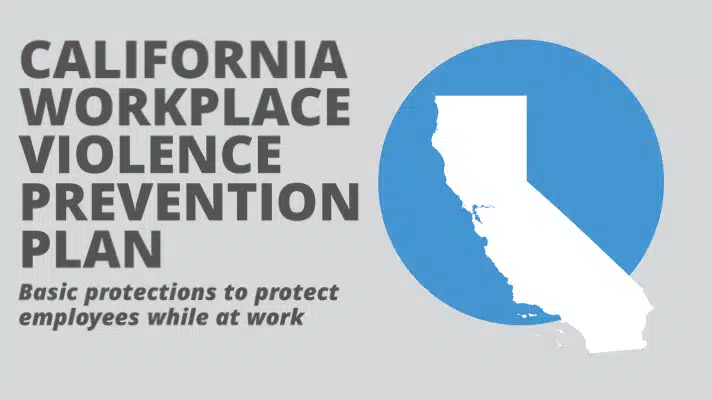Written By Chris Dolan and Elton Rosicki
Introduction
Navigating California’s employment laws can feel like exploring a legal labyrinth, filled with nuanced regulations and protections designed to govern the relationship between employers and employees, ensuring fair treatment, safety, and equality in the workplace. This article aims to clarify the complexities of California employment law by highlighting the essential aspects of At-Will Employment and Workplace Violence Protection Plans (WVPPs). By examining the intersection of these two components, employers can understand the evolving landscape of workplace regulations and the pivotal role WVPPs play in ensuring employee safety within the framework of at-will employment.
At-Will Employment
California operates under “at-will employment” principle, allowing employers to discharge employees at any time and for any reason, or even no reason at all, except when the termination is based on a protected class such as race, gender, sexual orientation, religion, disability status, and so on, or if there is an applicable exception. One exception is when an employee is terminated for opposing an unsafe or violent workplace, aligning with California Labor Code § 6310. Under this code, employers are prohibited from retaliating against employees who:
- make oral or written complaints about workplace safety or health to their employer, the government, or representative;
- participate in safety-related proceedings or testify in proceedings; or
- participate in an occupational health and safety committee.
If an employee is terminated in retaliation for exercising their rights under § 6310, they are entitled to reinstatement and reimbursement for lost wages and benefits. Employers who willfully refuse to rehire or restore the affected employee may face legal consequences.
Workplace Violence Prevention Plan (WVPP)
In response to rising concerns about workplace safety, California has enacted a comprehensive workplace violence prevention law that mandates public and private employers with California employees to implement tailored WVPPs by July 1, 2024, with some exceptions, such as places of employment with fewer than 10 employees present at any given time and not accessible to the public, employees telecommuting from a location of their own choosing, and healthcare facilities already covered by Section 3342 of Title 8 of the California Code of Regulations.
WVPP Implementation and Requirements
The California Division of Occupational Safety and Health’s (Cal/OSHA) model plan outlines the responsibilities of WVPP administrators, procedures for reporting and investigating workplace violence incidents, identifying and evaluating workplace violence hazards, emergency response protocols, employee training, and methods for reviewing and updating the plan. Employers can use the Cal/OSHA template, create their own, or incorporate workplace violence prevention into their existing Injury and Illness Prevention Program. WVPPs must be reviewed annually, after a deficiency is observed, and following any workplace violence event. A compliant WVPP must include:
- names or job titles of individuals responsible for the plan;
- procedures for employee participation in the plan’s development and implementation, including hazard identification, training, and incident reporting;
- methods for coordinating the plan with other employers, where applicable;
- procedures for responding to reports of workplace violence and prohibiting retaliation against those who report;
- ensuring both supervisory and non-supervisory employees adhere to the plan;
- communicating workplace violence issues to employees, including reporting incidents and how concerns will be investigated and resolved;
- responding to workplace violence emergencies, including alerting employees and coordinating evacuations;
- training procedures;
- identifying, evaluating, and correcting workplace violence hazards, including scheduled inspections;
- post-incident response and investigation; and
- reviewing and updating the plan’s effectiveness.
Training and Compliance
After implementing the WVPP, employers must immediately train employees and conduct annual training thereafter. The training must cover:
- identifying and evaluating workplace hazards;
- correcting unsafe conditions promptly;
- health and safety training specific to job hazards;
- ensuring compliance with safe practices, including disciplinary actions;
- employee participation in plan development and implementation;
- reporting and addressing workplace violence, with anti-retaliation measures;
- communicating incident reporting and workplace violence matters;
- investigating employee concerns;
- responding to workplace violence emergencies and coordinating evacuations;
- post-incident response and investigation;
- understanding and accessing the employer’s plan;
- specific hazards and corrective measures for each job;
- requirements and access to the violent incident log; and
- opportunities for interactive discussion.
Categorization
Type 1 violence:
Workplace violence committed by a person with no legitimate business reason to be at the worksite and includes violent acts by anyone who enters the workplace or approaches employees with the intent to commit a crime.
Type 2 violence:
Workplace violence directed at employees by customers, clients, patients, students, inmates or visitors.
Type 3 violence:
Workplace violence against an employee by a present or former employee, supervisor or manager.
Type 4 violence:
Workplace violence committed in the workplace by a person who does not work there but has or is known to have a personal relationship with an employee
Recordkeeping
Employers will also be required to maintain a log for every instance of workplace violence. The report must include:
- the date of the event;
- a detailed description of the incident;
- the categorization of the individual who committed the violence, such as a customer, stranger, co-worker, or partner or spouse;
- the circumstances leading up to the incident;
- the area where the incident occurred;
- the outcomes of the incident, including whether law enforcement was contacted and the actions taken by the employer to protect against ongoing threats; and
- Information regarding the person in charge of completing the record entry.
Employers are required to keep records of workplace violence hazard identification, evaluation, and correction; workplace violence incident investigations; and violent incident logs for five years, and training records for one year. All WVPP records must be accessible to Cal/OSHA upon request. Employees and their representatives are entitled to access records of hazard identification, evaluation, correction, and violent incident logs within 15 days of their request.
Violations and Penalties for Employers
Violations for non-compliance can result in penalties up to $25,000 for serious violations or $153,744 for willful violations, enforced by Cal/OSHA. Non-compliant employers must also mitigate infractions to Cal/OSHA’s satisfaction, which may include changes to policies and procedures.
Conclusion
With the July 1, 2024 deadline swiftly approaching, employers must act immediately to review the full requirements of SB 553 and prepare their WVPPs, violent incident logs, and employee training procedures if they have not already done so. Implementing WVPPs not only enhance workplace safety, but also demonstrate an organization’s commitment to ensuring the well-being of its employees and complying with regulations.
Christopher B. Dolan owns the Dolan Law Firm, and Elton Rosicki is a Law Student (Legal Intern) in our San Francisco office. We serve San Francisco Bay Area and California clients from our San Francisco, Oakland, and Los Angeles offices. Email questions and topics for future articles to help@dolanlawfirm.com. Each situation is different, and this column does not constitute legal advice. We recommend consulting with an experienced trial attorney to understand your rights fully.










